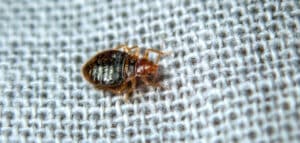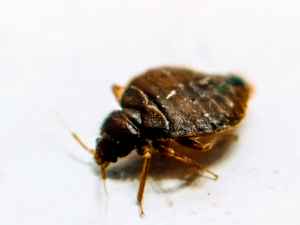Home / Blog / Bed Bugs / 10 Common Bugs That Look Like Bed Bugs
10 Common Bugs That Look Like Bed Bugs

Scientifically reviewed by Rachel Maldonado
-Published on May 17, 2024
-Updated on August 30, 2024
10 Common Bugs That Look Like Bed Bugs
If you’ve noticed some itchy welts on your skin, stains on your bed sheets, and unexplained bites, your first thought might be bed bugs. But hold on – before you toss and turn in a panic, it might not be what it seems.
Many household insects bear a striking resemblance to bed bugs but pose their own unique set of problems. In this guide, we’ll dissect ten common bug look alikes, allowing you to identify the true culprits in your home.
Remember, just because it’s small and brown doesn’t mean it’s bed bugs; pests come in all shapes and shades.
1. Bat Bugs
Starting with the most bedbug-like intruder, bat bugs are nearly identical in appearance, size, and behavior. The only discerning factor under a microscope is that the fringe hairs on the pronotum (the shield-like structure behind the head) of bat bugs are longer than those of bed bugs.
Despite the differences being microscopic, the presence of bat bugs indicates a larger problem – a nearby bat colony. Once bats are excluded, bat bugs should disappear within a few weeks – no professional extermination required.
2. Swallow Bugs
This bug species’ name betrays their origin – swallows, not the action. Swallow bugs primarily feed on these birds and share their living spaces.
Like bat bugs, the removal of their avian hosts is the key to a bug-free home. Swallow bugs are particularly stubborn and can go without feeding for many months. Once their primary food source is eliminated, it can take up to a year for them to die out.
3. Furniture Beetles
Furniture beetles and other wood-boring beetles, in general, are not blood-suckers. They are a type of weevil that lays its eggs inside wood. Once they hatch, the larvae consume the wood, often causing significant damage to furniture.
These pests are usually brought into the home through infested materials, and an opportunity to catch them exists in the monitoring of wood-dwelling insects. Keep note of the appearance of adult beetles, their disc-shaped bodies and long antennae, which bed bugs lack.
4. Booklice
Psocids, fondly known as booklice, are tiny, soft-bodied insects that, at a distance, can be mistaken for newly hatched bed bugs due to their pale color and size.
Unlike bed bugs, booklice feed on microscopic mold and fungi that grow in damp corners and on papers. Eliminating the moisture in the environment and cleaning affected areas with appropriate detergents usually curbs their numbers.
5. Sowbugs and Pillbugs
These crustaceans cause lots of confusion for folks with their bug-like appearance and habit of infesting damp environments, like basements and cellars.
Sowbugs and pillbugs are perfectly harmless; they don’t bite, sting, or transmit any diseases, and they don’t even damage plants. They’re scavengers that help to break down decaying matter. If they’re in your home, it’s likely a sign of excessive moisture and decay; fixing these issues will resolve the infestation.
6. Carpet Beetles
Carpet beetles are often discovered to be the culprit of ‘bed bug’ bites in homes where no bed bugs are found. They are recognizable by their round, dome-shaped bodies with patterns of scales on their wings.
It’s the larvae of carpet beetles that are particularly troublesome, as they feed on natural fibers, like wool, and can damage carpets, clothing, and other textiles. Proper sanitation, regular vacuuming, and storage of fabrics in airtight containers can help prevent or control an infestation.
7. Cockroach Nymphs
Before cockroaches reach adulthood, they are nymphs, and early stages can look startlingly like bed bugs – small, brown, and flat. An important distinction is the cockroach’s antennae and the way they move.
With a clear examination, their six legs and pair of long, segmented antennae should help to tell the difference. Cockroaches are indicators of poor hygiene and can pose health risks due to their association with garbage and filth.
8. Spider Beetles
These are tiny and oval shaped, much like the common bed bug. However, a magnification glass would reveal their beetle-like appearance – with six legs, shiny, and hard exoskeletons.
Spider beetles get their name from their web-creating kin, but they’re just content to feed on a variety of foods including grain, cereals, and rodent baits. Keeping areas clean and free of these food sources will send them packing.
9. Fleas
Fleas fit the size and color profile of bed bugs, and their bites can sometimes be mistakenly attributed to bed bugs.
However, the diagnostic sign of fleas is upon the host – if you’ve noticed your pet scratching or nibbing, that’s often a tell tale sign. Flea treatments should be coordinated with pet treatments to address eggs, larvae, and adults in the environment.
10. Mites
Mites are arachnids, not insects, but they sometimes find their way into the bed bug misidentification mix due to their propensity for biting and their minuscule size.
While some species are harmless, others like the scabies mite or the bird mite are associated with skin conditions. Proper identification by a dermatologist or entomologist based on the symptoms and location of the irritation is crucial to address any mite issues properly.
The Takeaway
Remember, at the first hint of a bed bug infestation (or an infestation from one of these look-alikes), consult with a professional pest control service.
At Hawx Pest Control, you can join our family of satisfied customers. Our expert technicians are waiting to help you sleep soundly once more.
Take the first step to a pest-free environment by reaching out to Hawx to identify – and rid your home of – any unwelcome guests.
Related Articles
Visit our blog to learn more.
→








